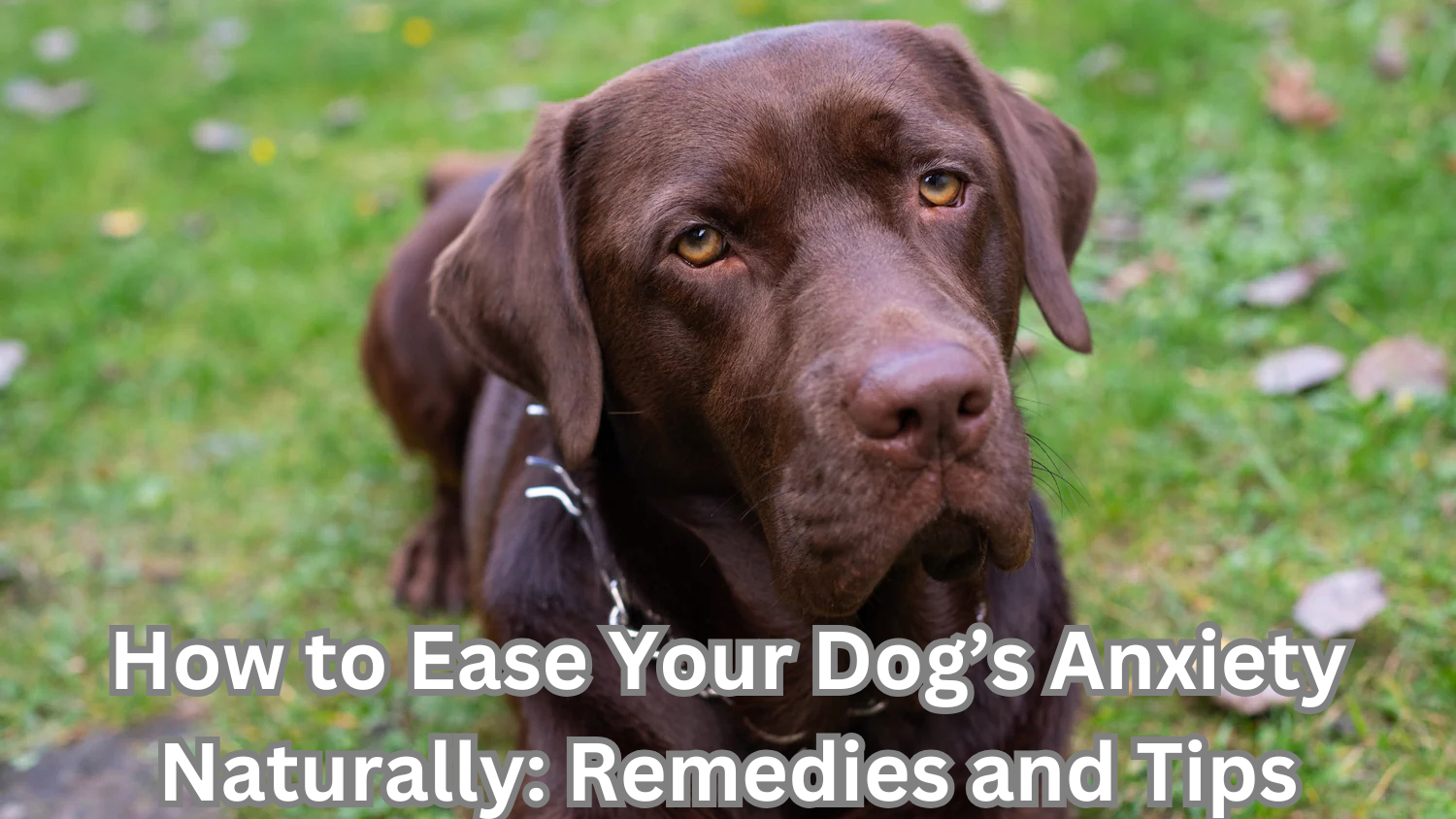How to Ease Your Dog’s Anxiety Naturally: Remedies and Tips

Understanding Dog Anxiety
The Basics of Dog Anxiety
Dog anxiety is a prevalent issue that affects many canines, often stemming from their past experiences or current situations. Recognizing the underlying causes is crucial for effective intervention. Common triggers of anxiety include:
- Abandonment: Dogs that have been abandoned may exhibit signs of fear when left alone.
- Loud Noises: Fireworks, thunderstorms, or even loud machinery can cause significant distress.
- New Environments: Traveling, a new home, or new people can lead to feelings of insecurity.
Understanding these factors helps pet owners address their dogs’ anxiety with compassion and care, ensuring a healthier and happier life together.
Signs and Symptoms of Dog Anxiety
Recognizing Anxiety in Your Dog
Identifying signs of anxiety in dogs is crucial for timely intervention. While every dog may express anxiety differently, there are common symptoms that can signal distress. Owners should look for:
- Excessive Barking: Anxious dogs often bark more than usual, indicating discomfort.
- Destructive Behavior: Chewing furniture or other items can be a cry for help.
- Pacing or Restlessness: Dogs may struggle to stay still when feeling anxious.
For example, when a thunderstorm approaches, a dog might start hiding, or pacing around the house. Monitoring these signs can help in understanding your pup’s emotional state, paving the way for effective calming strategies.
Natural Remedies for Dog Anxiety
Essential Oils
Essential oils can be a wonderful ally in calming anxious dogs. Aromatherapy, employing oils like lavender and chamomile, can create a soothing atmosphere. For instance, using a diffuser filled with lavender oil can help ease a dog’s nerves during fireworks. However, it’s crucial to ensure your dog has the ability to leave the space if they feel overwhelmed.
- Diluted Oils: Always dilute oils with a carrier oil before applying.
- Hydrosols: Consider using less concentrated hydrosols, which are gentler on dogs.
Herbal Supplements
Herbal supplements are another effective natural approach to alleviate dog anxiety. Herbs such as chamomile and valerian root are known for their calming properties. For example, chamomile tea can soothe a nervous pup’s stomach during car rides.
- Dosage: Always consult your vet before introducing new herbs.
- Forms: Herbs can be administered as teas, tinctures, or capsules.
Finding the right natural remedy can significantly improve your dog’s quality of life and reduce anxiety levels.
Lifestyle Changes to Reduce Dog Anxiety
Exercise and Play
Regular exercise and playtime are essential for maintaining your dog’s mental and physical well-being. Engaging in physical activities not only helps to burn off excess energy but also releases feel-good endorphins, which can reduce anxiety. Activities like:
- Walking: A daily stroll can do wonders for both you and your dog.
- Fetch: Playing fetch not only boosts stamina but also fosters bonding.
- Puzzle Toys: These can provide mental stimulation and keep their minds active.
I’ve seen firsthand how an hour of play can transform a jittery pup into a relaxed companion!
Creating a Safe Space
Establishing a safe haven can also significantly ease your dog’s anxiety. Designate a quiet area in your home where they can retreat when feeling stressed. Consider:
- Comforting Items: Add their favorite blanket or toys.
- Low Lighting: Use soft lighting or a cozy bed to create a calming atmosphere.
- Noise Reduction: Use soundproofing or soothing background noise to minimize distractions.
This little sanctuary can help your dog feel secure and reduce anxiety during stressful situations, such as thunderstorms or when guests arrive.
Training Techniques to Calm Your Anxious Dog
Desensitization
Desensitization is a powerful technique to help your dog gradually acclimate to anxiety-inducing stimuli. It involves exposing your dog to the source of their anxiety at a low intensity and slowly increasing exposure over time. For instance, if your dog fears loud noises, start by playing recordings at a low volume while rewarding calm behavior.
- Steps to Implement:
- Begin with a sound that’s barely audible.
- Gradually increase the volume as your dog becomes more comfortable.
I used this with my dog during fireworks season, and it worked wonders!
Counterconditioning
Counterconditioning involves changing your dog’s emotional response to a trigger from negative to positive. For example, if your dog is scared of strangers, reward them with treats when someone enters your home. This helps them associate people with good experiences.
- Practical Steps:
- Identify the trigger for your dog’s anxiety.
- Use high-value treats to reinforce calm behavior when the trigger occurs.
Over time, this association can transform your dog’s response, making a stressful situation much more manageable.
Dietary Adjustments for Anxious Dogs
Nourishing Calmness Through Nutrition
Dietary adjustments can play a significant role in managing your dog’s anxiety. Providing a well-balanced diet rich in nutrients is essential for overall well-being. Certain ingredients can naturally promote calmness and reduce anxiety levels. Consider the following:
- Omega-3 Fatty Acids: Found in fish oil, these can help reduce anxiety and support brain health.
- Complex Carbohydrates: Foods like sweet potatoes or brown rice can increase serotonin production, promoting feelings of relaxation.
My dog benefited from a dietary change that included fish oil, and I noticed a remarkable difference in her anxiety levels during storms. Always consult with your veterinarian to tailor a diet that best suits your dog’s unique needs!
Using Pressure Wraps and Calming Products
The Power of Pressure Wraps
Pressure wraps, such as Thundershirts, can be incredibly helpful in managing your dog’s anxiety. These snug-fitting garments provide a comforting pressure similar to a gentle hug, helping to soothe anxious behaviors. Many pet owners have reported that their dogs respond positively during stressful situations like thunderstorms or fireworks.
- Trial and Error: Every dog is different; while some thrive in wraps, others might find them uncomfortable.
- Proper Fit: Make sure the wrap fits snugly but is not restrictive, allowing two fingers’ width underneath.
Calming Products to Consider
In addition to pressure wraps, there are various calming products like pheromone diffusers and calming sprays that can help ease anxiety. For instance:
- Dog Appeasing Pheromones: These mimic the natural pheromones released by mother dogs and create a calming environment.
- Calming Music: Specific playlists designed for dogs can also work wonders in reducing stress.
When used in combination, these products can create a soothing atmosphere, helping your furry friend relax and feel secure.
Incorporating Relaxation Techniques
Finding Calm for Your Canine
Incorporating relaxation techniques into your dog’s daily routine can significantly diminish their anxiety levels. Techniques like gentle massage or calming music can create a serene environment that encourages relaxation. For instance, I’ve found that playing soothing classical music during nap times has made my dog’s resting periods more peaceful.
- Massage: Use long, slow strokes to help ease muscle tension and promote relaxation.
- Calming Activities: Engage your dog in calming games, such as gentle fetch or hide-and-seek with treats.
These simple strategies can work wonders, making your furry friend feel safe and secure.
Building a Routine for Your Anxious Dog
Creating Predictability and Security
Establishing a consistent routine can do wonders for reducing anxiety in dogs. Like us, dogs thrive on predictability; it helps them feel secure in their environment. Here are a few tips to craft that routine:
- Feeding Schedule: Serve meals at the same time each day, which allows your dog to anticipate their next feeding.
- Exercise Routine: Regular walks or playtime not only expend energy but also foster a bond between you and your dog.
I’ve observed that sticking to a set schedule greatly calms my anxious pup, especially when it comes to his bedtime routine. A predictable day makes for a happier, less anxious dog!
Seeking Professional Help
When Is It Time to Consult an Expert?
If your dog’s anxiety persists despite trying various calming techniques, it may be time to seek professional help. Expert trainers and veterinarians can assess the situation more thoroughly to determine underlying issues.
- Veterinary Behaviorists: They specialize in animal behavior and can create a tailored treatment plan.
- Training Courses: Sometimes, enrolling in a behavior modification class can lead to significant changes.
I recall how my friend’s dog had severe separation anxiety. After consulting a behaviorist, they implemented techniques that made their dog much more comfortable being alone. Professional guidance can be invaluable in ensuring your pet’s well-being.
XII. Conclusion
Summing Up Your Dog’s Well-Being
Incorporating natural methods to manage your dog’s anxiety can greatly enhance their quality of life. Whether it’s establishing a consistent routine, utilizing calming products, or engaging in soothing activities, every little change can make a difference.
- Be Patient: It takes time to find what works best for your pup.
- Consult Experts: Don’t hesitate to reach out to your veterinarian for tailored advice.
I’ve found that combining these techniques has been beneficial for my anxious dog, creating a more peaceful home for both of us. Remember, a happy dog means a happy owner!












